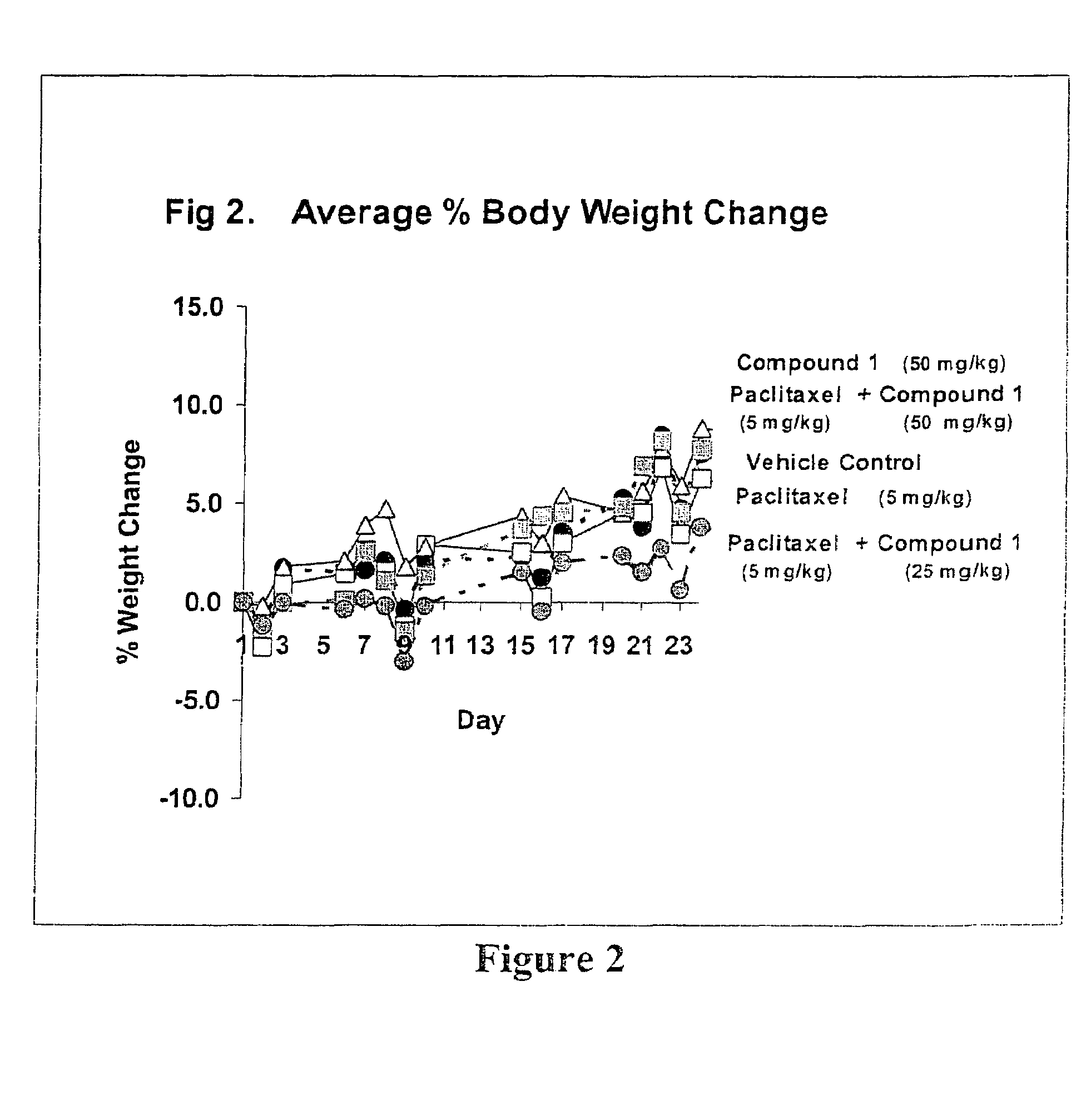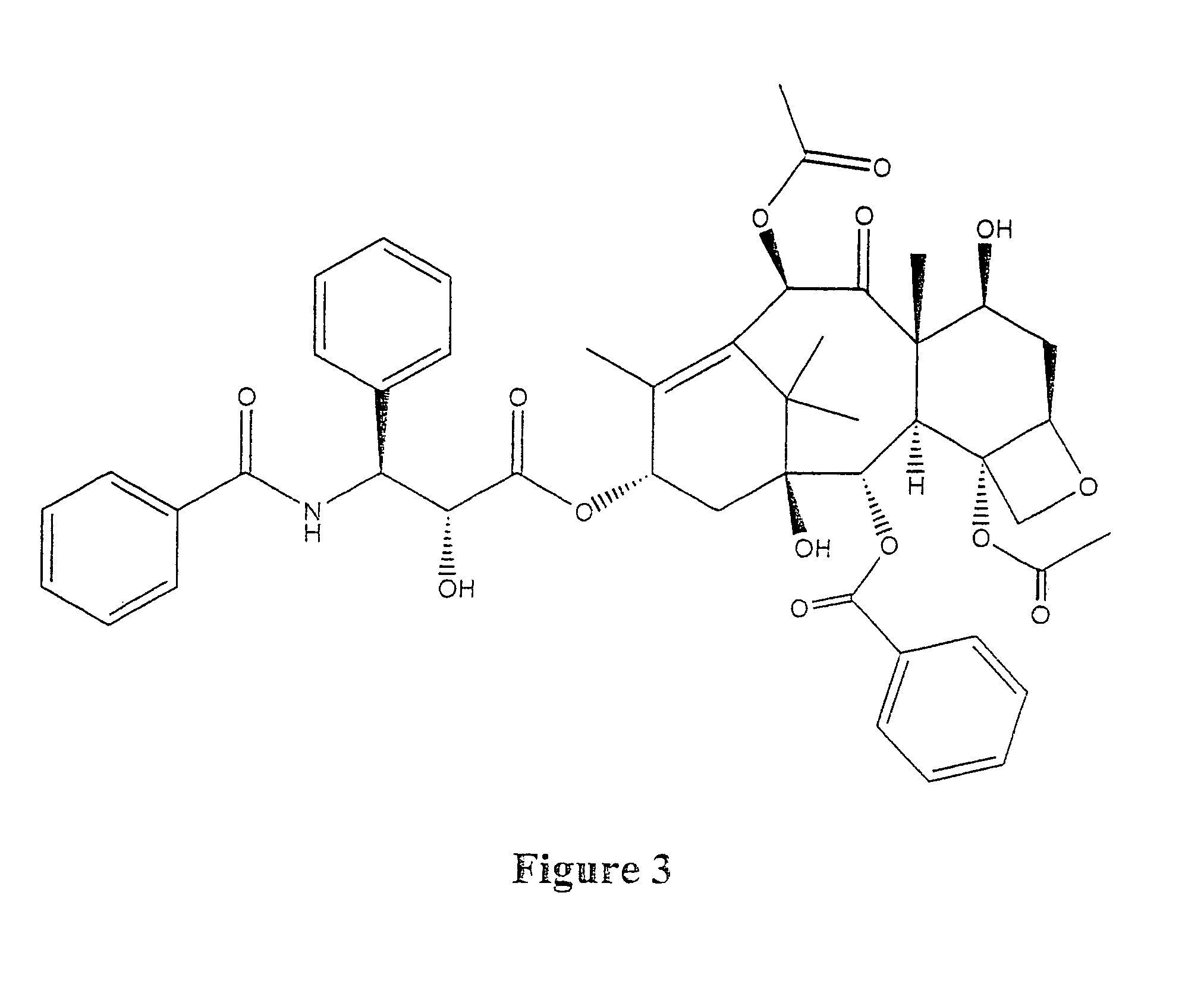Taxol enhancer compounds
a technology of taxol and enhancers, which is applied in the direction of amide active ingredients, curling devices, drug compositions, etc., can solve the problems of reducing the anti-cancer activity of taxol, and toxicity of anti-cancer agents, so as to reduce the toxic side effects, increase the anti-cancer activity of taxol, and reduce the effect of toxic side effects
- Summary
- Abstract
- Description
- Claims
- Application Information
AI Technical Summary
Benefits of technology
Problems solved by technology
Method used
Image
Examples
example 1
[0079]
Preparation of N-Malonyl-bis[N′-phenyl-N′-(thioacetyl)hydrazide]
[0080]
[0081]A mixture of phenylhydrazine (30 mL) and ethyl malonate (in xylene (150 mL) was heated to reflux overnight. The reaction was cooled to room temperature. The precipitates were collected via filtration and washed with ethanol to give N-malonyl-bis(N′-phenylhydrazide) as a white solid (14 g). The hydrazide (3.4 g) was suspended in acetic anhydride (30 mL) and cooled in an ice bath. To it was added dropwise perchloric acid (57% in water, 3 mL). The reaction mixture turned to clear solution initially and then quickly solidified. After standing at room temperature for 1 h, ether (50 mL) was added. The resulting slurry was filtered and washed with ether (2×00 mL) to give the perchlorate salts as a white solid (5.7 g). The salts were taken into acetone and added as a slurry over 5 min to Na2S (0.6 M in water, 90 mL) stirred at room temperature. After 30 min, the reaction was acidified with HCl(c) to afford a y...
example 2
[0082]
Preparation of Thiocyclohexanoic acid N-phenylhydrazide
[0083]Phenyl hydrazine (5.4 g, 50 mmol) was dissolved in dry dichloromethane (50 mL) in a 250 mL round bottom flask. Di-tert-butyl dicarbonate (10.9 g, 50 mmol) was then added with stirring at 0° C. The resultant solution was then stirred under reflux for 3 h. Removal of the volatile components under reduced pressure afforded a colorless solid, which was washed with hexane and dried in vacuo. 10 g (yield 96%) of the product was obtained as a colorless solid, which can be used in the next step without further purification. 2.5 g (12 mmol) of this material was dissolved in dry pyridine (5 mL). Cyclohexanecarbonyl chloride (2.0 mL, 15 mmol) was then added slowly at 0° C. The red solution was stirred at 0° C. for half an hour and the resultant yellow suspension was stirred at rt for 3 h before pouring into ice-H2O (100 mL). The precipitate product was collected by filtration and washed thoroughly with H2O. After one recrystall...
example 3
[0086]
[0087]To a stirred solution of cyclohexanoic acid N-phenylhydrazide (0.1 g, 0.45 mmol) in dry benzene (5 mL) was added P2S5 (0.2 g, 0.45 mol). The resultant suspension was heated to reflux for 3 h. After being cooled to room temperature, the mixture was diluted with benzene (5 mL) and was filtered through a short column of silica gel (2 g), washed with benzene and 2:1 hexane / EtOAc (15 mL each). The filtrate and washings were combined and concentrated to afford a solid. Crystallized from hexane to provide the intermediate thiocyclohexanoic acid N-phenylhydrazide as an off white solid; 1H NMR (CDCl3) δ 0.8–2.4 (m, 11H), 5.65 (br, 1H), 7.1–7.6 (m, 5H); ESMS calcd (C13H18N2S): 234.1; found: 235.1 (M+H)+.
PUM
| Property | Measurement | Unit |
|---|---|---|
| Composition | aaaaa | aaaaa |
| Covalent bond | aaaaa | aaaaa |
Abstract
Description
Claims
Application Information
 Login to View More
Login to View More - R&D
- Intellectual Property
- Life Sciences
- Materials
- Tech Scout
- Unparalleled Data Quality
- Higher Quality Content
- 60% Fewer Hallucinations
Browse by: Latest US Patents, China's latest patents, Technical Efficacy Thesaurus, Application Domain, Technology Topic, Popular Technical Reports.
© 2025 PatSnap. All rights reserved.Legal|Privacy policy|Modern Slavery Act Transparency Statement|Sitemap|About US| Contact US: help@patsnap.com



